The capital of the picturesque region of Tuscany, Florence is the cradle of Renaissance art and architecture and one of the most beautiful cities in Italy.
Boasting stunning historical landmarks, beautiful churches, medieval squares and buildings, and many remarkable museums, the landmarks of Florence have much to offer every kind of traveler.
| ⌛ Planning your trip to Florence at the last minute? Here are my quick picks on what to do & where to stay! 🍷 Top Florence Experiences: 1. Tuscany Wine & Food Tour with Guide (#1 day trip!) 2. Florence Duomo Visit & Bruneschelli Dome Climb (#1 attraction!) 3. Art Tour of the Uffizi & Accademia (see the Uffizi & Statue of David) 🏨 Best Florence Hotels: 1. Cicerone (charming central Florence guesthouse) 2. Piccolo Borgo Antico (quiet studios near Boboli Gardens) 3. Hotel Unicorno (beautifully revamped 17th century building) ✈️ Flying in? Book an airport transfer with Welcome Pickups — they’ll greet you at the airport, help with bags, & bring you into the city, all pre-booked! |
The architecture and art in Florence were greatly influenced by the House of Medici, a noble family and political dynasty that ruled Florence between the 13th and 18th centuries.
Florence is best-known for the impressive Duomo complex, one of the most beautiful churches in Italy, and the famous Giotto Bell Tower which offers sweeping views of the city.

Welcome to Florence: be sure to walk along the Arno River, explore the squares and alleys, and try delicious Tuscan food.
But most of all, make sure not to miss adding these stunning landmarks to your Florence itinerary, even if you just have one day in Florence!
Map of Florence Attractions
The Best Florence Landmarks
Cathedral Santa Maria del Fiore (Duomo di Firenze)

By far, the most important landmark in Florence is the Cathedral of Santa Maria del Fiore, also known as the Duomo of Florence (I’ve written a full guide to visiting here).
At the time of its completion in the 15th century, the cathedral was the largest in Europe, and it’s still the 11th largest in the world.
Together with the Baptistery of St. John and Giotto’s Bell Tower, the cathedral is a UNESCO World Heritage Site.
The most important feature of the cathedral is the dome engineered by Filippo Brunelleschi, which towers over Florence’s rooftops and offers an epic view.
The dome’s ceiling is decorated with a fresco of The Last Judgment by Giorgio Vasari and Federico Zuccari.
Filippo Brunelleschi and Giotto di Bondone are buried in the cathedral’s crypt, along with other personalities.
The crypt stands in the place of a former 5th-century church, Santa Reparata, which was only discovered in the second half of the 20th century.
You can visit the cathedral free of charge, but there’s a fee to climb to the top of the dome and to visit Santa Reparata.
The most convenient way to visit all the monuments in Piazza del Duomo is via a guided tour that includes access to the Duomo, Brunelleschi’s Dome, the Crypt of Santa Reparata, the Baptistery, and Giotto’s Bell Tower.
If budget is a concern, you can skip going up the dome and just book skip-the-line tickets to the Duomo interior.
You won’t get to see the amazing frescoes in the Dome or the stunning views from up top, but it is a more affordable and less time-consuming way to appreciate this Florence landmark.
Giotto’s Tower
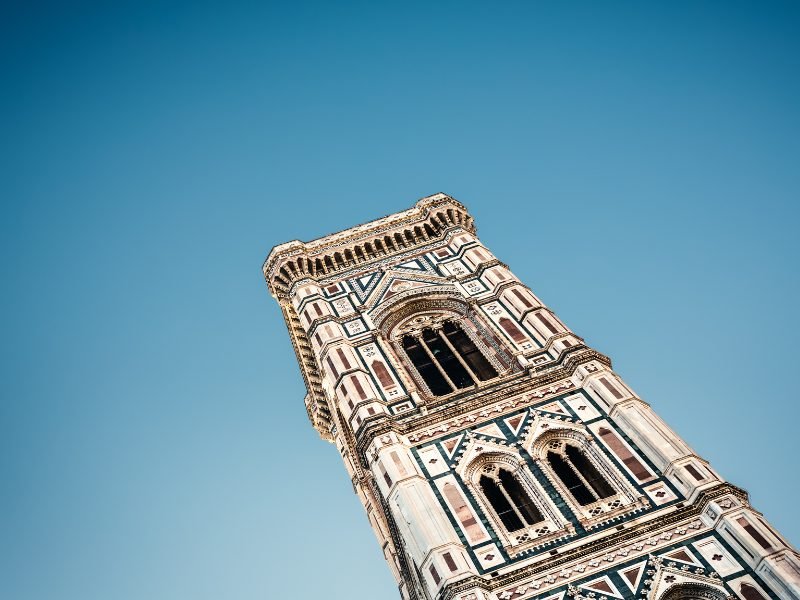
Next to the Duomo, Giotto’s Tower is an 85 meters tall (278 feet) bell tower offering gorgeous views of the city.
The tower is part of the Duomo complex, so the visit is included with a Brunelleschi tour like this.
To reach the top of the tower, you need to climb 414 steps, so you’ll get a small cardio workout in too!
For an easier climb, there are three intermediate floors where you can rest and enjoy the view.
The beautifully decorated tower is one of the symbols of Florentine Gothic architecture, designed by painter and architect Giotto di Bondone in 1334.
On the outside, the tower seems painted, but it’s actually covered in different colors of marble!
You’ll find white marble from Carrara, red marble from Siena, and green marble from Prato.
The Baptistery of St. John

Opposite Santa Maria del Fiore Cathedral, the Baptistery of St. John is another monument of the Duomo complex.
The octagonal building is covered in white Carrara marble and green marble from Prato and features three bronze doors decorated with relief sculptures.
The baptistery you can visit today is the result of a renovation of an earlier one dating to the 4th or 5th century CE.
The present baptistery was built between 1059 and 1128 in the Romanesque style.
On the inside, you’ll find several impressive features, such as the mosaic ceiling depicting The Last Judgment, choirs of angels, and other biblical stories.
Opera del Duomo di Firenze

The Opera del Duomo Museum is a relatively recent addition to Piazza del Duomo, initially opened in 1891 and renovated in 2015.
The museum allows you to discover the history of the impressive Duomo complex, which is considered the cradle of Renaissance art.
Inside the museum, you can admire beautiful art pieces that once decorated the buildings in the square, including masterpieces by Michelangelo, Donatello, Brunelleschi, and Ghiberti.
The visit to the Opera del Duomo is not included on every tour, so be sure to find one that specifically includes it, such as this small group tour.
Book your tour of the Duomo complex and the opera del Duomo here!
Uffizi Gallery

The Uffizi Gallery is among Italy’s most important art galleries, housed in a 16th-century building designed by Giorgio Vasari.
The gallery houses some of the most important works created between the Middle Ages and the modern area, passing through the Renaissance.
In the Uffizi, you’ll admire works by Raphael, Giotto, Michelangelo, Caravaggio, Leonardo Da Vinci, and others.
Some of the masterpieces inside this famous Florence landmark are the Birth of Venus by Botticelli, Medusa by Caravaggio, the Venus of Urbino by Titian, and La Primavera by Botticelli.
You can buy your tickets for the Uffizi Gallery online. You’ll usually have no problem booking for the next day during the low season.
If you visit in the summer, you will definitely want to book ahead of time to be able to choose your desired time slot.
Even if you’re visiting Florence in winter, this is a top attraction, so you’ll still want to book ahead so you won’t be disappointed.
Galleria dell’Accademia & the Statue of David

Galleria dell’Accademia is well worth a visit for its many pieces of art, but it’s best-known for housing the famous David by Michelangelo.
I’ve written a full guide on how to see the Statue of David in Florence here.
The impressive collection also includes paintings from the 13th to the 15th centuries by renowned artists like Giotto, Botticelli, Ghirlandaio, and Michelangelo.
Among the sculptures, the most valuable ones are by Giambologna, Lorenzo Bartolini, and Michelangelo.
The gallery also houses a collection of musical instruments and historical archives.
The gallery is open daily except for Mondays, and tickets are available online.
Being much smaller than the Uffizi, the tickets for the Galleria dell’Accademia tend to sell out faster.
Be sure to book them at least four or five days in advance, even in the low season!
Tip: We have a full guide to seeing the Statue of David here!
Piazza della Signoria

At the heart of Florence, Piazza della Signoria is one of the city’s largest and most important squares.
Archaeological findings indicate that the square existed already during prehistorical times, and it was an important area in the ancient Roman city that predated Florence.
The square as you see it today started taking shape in the second half of the 13th century.
All around the square you will see many important Florence landmarks, like Palazzo Vecchio, Loggia della Signoria, and Palazzo Uguccioni.
The square is also famous for the sculptures in front of Palazzo Vecchio, including works by Donatello and a copy of the David of Michelangelo.
You’ll inevitably walk around Piazza della Signoria many times during your stay in Florence!
Don’t forget to check out the beautiful buildings, sculptures, and the stunning Fountain of Neptune.
Palazzo Vecchio
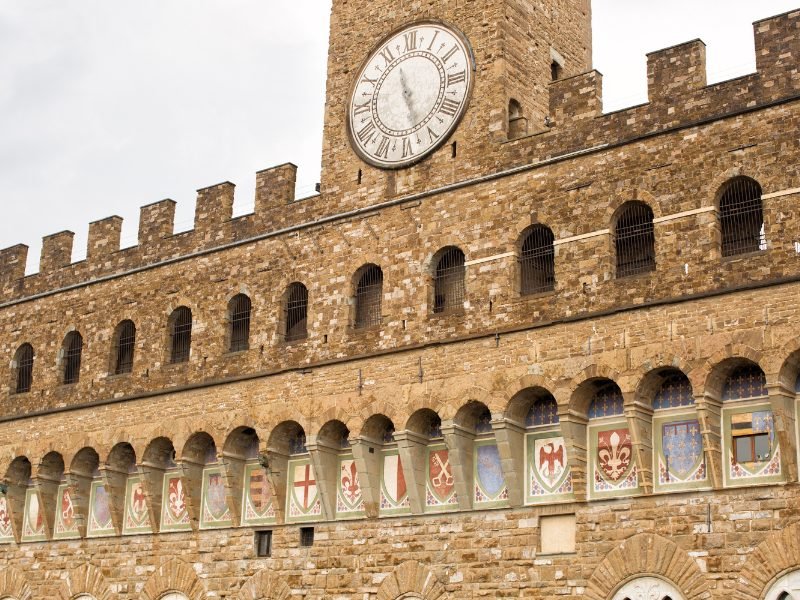
Palazzo Vecchio, formerly Palazzo della Signoria, is a 13th-century building and the town hall of Florence.
The iconic building is one of the most famous attractions in Florence and now houses a museum where you can learn more about the city’s long history.
On the first floor, the Salone dei Cinquecento is a vast Renaissance room covered in frescoes by Giorgio Vasari.
On the second floor, you can visit the Apartments of the Elements, the Apartments of Eleonora of Toledo, and the Apartments of the Priori.
Tip: For amazing views of Florence, climb to the top of the tower!
Ponte Vecchio

Of the many bridges across the Arno River, Ponte Vecchio is by far the most picturesque!
As the name suggests, Ponte Vecchio is the oldest bridge in Florence. Because it was the only medieval bridge to survive the Second World War, there’s nothing else like it in the city.
The pedestrian bridge is lined with shops, in particular jewelry and souvenir stores.
Walk along the bridge to enjoy the view of the river and check out the shops, or go for a stroll along the Lungarno to admire the colorful Ponte Vecchio from afar!
Basilica of Santa Maria Novella

The Basilica of Santa Maria Novella is a 13th-century church founded by the monks of the Dominican Order.
The beautiful church is famous for housing important artworks by some of the most important artists of the time, including Giotto, Brunelleschi, Michelangelo, Ghirlandaio, Botticelli, and Vasari.
The marble façade of the basilica was only completed in 1920, so it’s more modern than the exterior.
On the inside, some of the most important sights are the Filippo Strozzi Chapel and the Tornabuoni Chapel, both covered in frescoes.
You can enter the church for free during mass, but there is a fee to visit it at other times, and to admire the artwork within it.
Cappella Brancacci

Housed inside the Church of Santa Maria del Carmine, Cappella Brancacci is a salient example of Renaissance art.
The chapel was decorated between 1424 and 1428 by two of the most renowned artists of the time, Masaccio and Masolino da Panicale.
The chapel’s name comes from the noble family that owned it already in the 14th century.
The frescoes covering the walls depict biblical themes, from The Temptation of Adam and Eve and The Expulsion from the Garden of Eden to scenes from St. Peter and St. Paul’s lives.
To visit the chapel, book your ticket online a few days in advance. Tickets may sell out, especially during the high season.
Pitti Palace
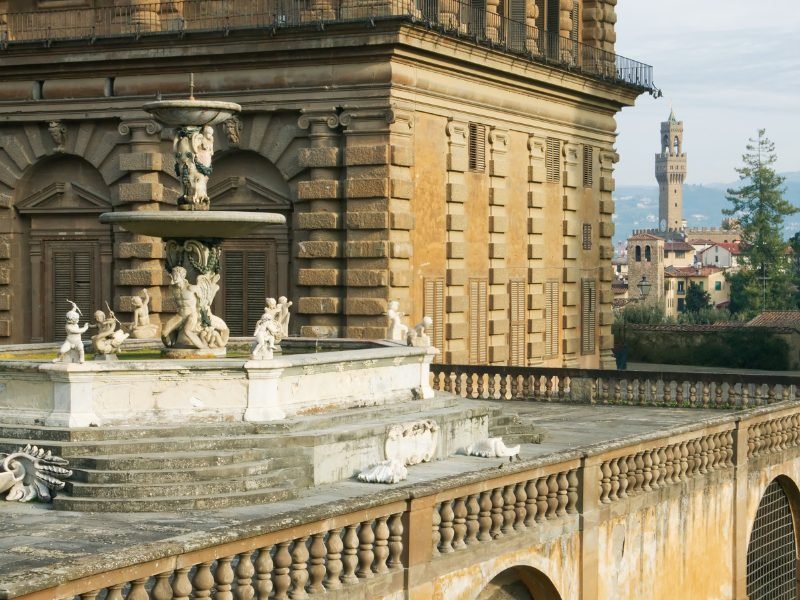
Pitti Palace used to be the symbol of the Medici’s power in the 16th century when the family bought it as the new Grand Ducal residence.
However, the palace is still named after its first owner, the successful banker Luca Pitti.
Nowadays, the palace houses several museums: the Treasury of the Grand Dukes, the Museum of Russian Icons, the Palatine Gallery, the Imperial and Royal Apartments, the Gallery of Modern Art, and the Museum of Costume and Fashion.
Pitti Palace is undoubtedly one of the must-see museums in Florence, so be sure to buy tickets in advance in the high season!
Palazzo Strozzi

Palazzo Strozzi once belonged to a rich merchant rival of the Medici family.
Built in the late 15th century, the magnificent palace is an important example of Renaissance architecture.
Palazzo Strozzi features a beautiful inner courtyard surrounded by an arched portico that often houses art exhibits.
Aside from checking out the permanent collection and exploring the beautiful building, you can also see temporary exhibitions, like the Olafur Eliasson exhibition, available until the end of January 2023.
On Thursdays, you can visit the museum until 11 PM.
Museo Galileo

Museo Galileo houses a vast collection of artifacts dating to the 15th and 16th centuries.
The collection includes relics collected by the Medici family in the late 16th century and the Grand Duke Peter Leopold Habsburg-Lorraine in the 18th century.
The permanent collection includes astrological instruments, celestial and terrestrial globes, microscopes, surgical instruments, Galileo’s telescope, and many other scientific artifacts.
If you’re curious about science and its evolution over the centuries, this is a must-see attraction in Florence!
Bargello National Museum

Bargello National Museum opened in 1864 as Italy’s first national museum after Italy was unified in 1861.
Housing a significant collection of Renaissance sculptures, paintings, bronzes, ceramics, tapestries, and other items, the Bargello is one of the best museums in Florence dedicated to medieval and Renaissance art.
Among the sculptures, you’ll see works by Michelangelo, Giambologna, and Donatello.
The museum also houses the oldest known portrait of poet Dane Alighieri, an excellent collection of Islamic art, and bronze tiles created by Ghiberti and Brunelleschi in their competition to design the doors of St. John’s Baptistery.
Piazzale Michelangelo

For one of the best panoramic views of Florence, you must visit Piazzale Michelangelo.
In the Oltrarno district on a hill on the opposite side of the Arno from Florence’s historical center, this lovely square will reward you with a view well worth the climb!
The best time to visit Piazzale Michelangelo is at sunset, to watch the sun go down behind the rooftops of Florence.
You can expect to find many people around and street artists playing live music.
Many Florence attractions have a significant entry cost, which can definitely add up if you are trying to visit a bunch of Florence landmarks.
But walking to Piazzale Michelangelo is one of the best free things you can do in Florence!
Giardino di Boboli (Boboli Gardens)

Near Pitti Palace, the wonderful Boboli Gardens boast impressive fountains and gorgeous Renaissance sculptures, with the historical center of Florence providing a perfect backdrop!
The gardens were created by the Medici family and soon became a model for other European gardens all around the continent.
Some of the spots you should not miss in the vast gardens are the Artichoke Fountain, the Fountain of Neptune, the Fountain of the Ocean, and the Kaffeehaus.
There’s also the Grotto of Adam and Eve, the Madama Grotto, the Buontalenti Grotto, the Knight’s Building and Rampart, and the Upper Botanical Garden.
You’ll need a ticket to visit the Boboli Gardens, which you can book in advance here.
Museo Salvatore Ferragamo

If you’re passionate about fashion, you must pay a visit to Museo Salvatore Ferragamo!
The Ferragamo family opened the museum in 1995 to show the world the genius of Salvatore Ferragamo, one of the most outstanding fashion designers of the 20th century.
He is best-known for his shoe designs, who provided gorgeous footwear for countless celebrities over his career, including Marilyn Monroe.
You can see his shoe designs on display in the museum.
Along with the permanent collection, you can also see temporary exhibitions dedicated to movements in the fashion world.
Basilica di San Lorenzo

Basilica di San Lorenzo is the oldest cathedral in Florence, dating back to the late 4th century and dedicated to the martyr San Lorenzo (St. Lawrence).
However, the ancient basilica was destroyed and renovated entirely in 1418 by Giovanni di Bicci, founder of the Medici family.
The façade of the church was supposed to be covered in marble, but the project, assigned to Michelangelo, was never completed — hence the unfinished look of the church.
The entry ticket includers the basilica, the old sacristy, the cloisters, the crypt, and the Museum of the Treasury of the Basilica.
Le Cappelle Medicee (Medici Chapels)
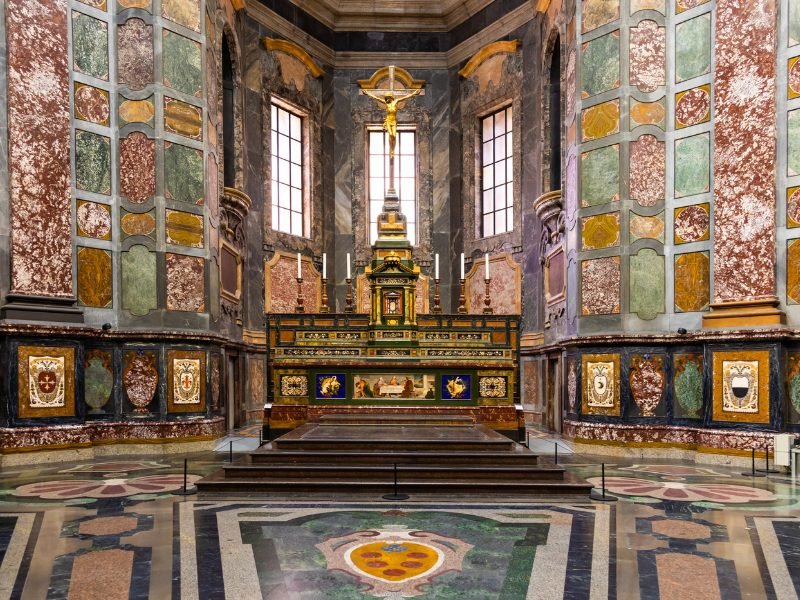
The Medici Chapels belong to the Basilica di San Lorenzo, but the access is separate from the church, so you’ll need to book a ticket separately.
The two buildings were built in the 16th and 17th centuries as an extension of the church in honor of the Medici family.
The museum complex opened in 1869 and includes the New Sacristy designed by Michelangelo and the impressive Chapel of the Princes decorated with polychrome marble and semi-precious stones.
And of course, you’ll also find the crypts housing the tombs of many Medici family members and the remains of the Lorena family.
This is one of the top-visited landmarks in Florence, so book your tickets in advance to ensure you won’t miss out!
Riccardi Medici Palace

Another building that belonged to the powerful Medici family, the Riccardi Medici Palace was built in the 15th century based on a design by Renaissance architect Michelozzo.
The palace was the first one where the Medici family lived, and it served as a workplace for Renaissance artists such as Donatello, Michelangelo, Botticelli, and others.
The palace features a lovely Renaissance courtyard, a garden decorated with sculptures, the Magi Chapel decorated with colorful frescoes of the Medici family and other personalities of the time.
It also hosts the stunning Gallery Luca Giordano with golden decorations on the walls and a frescoed ceiling.
Museo Leonardo da Vinci

One of the most prominent figures of the Renaissance was born in the former Republic of Florence — of course, we’re talking about da Vinci!
As everyone knows, Leonardo da Vinci was both an artist and scientist who created a vast collection of artistic masterpieces and scientific devices.
When in Florence, a great way to learn more about the genius of Leonardo da Vinci is to visit a museum entirely dedicated to him!
The highly interactive Museo Leonardo da Vinci houses a vast collection of machines created based on Leonardo’s original sketches.
You can book tickets online in advance here.
Villa Bardini

Many of the best viewpoints of Florence are in the Oltrarno district, as it faces the historical center of Florence.
The 17th-century Villa Bardini, located in the Oltrarno district, features a stunning garden offering a panoramic view of Florence!
The gardens and villa passed through several noble families of Florence before being bought by art dealer Stefano Bardini in the 1900s.
The villa now houses the Museo Annigoni, dedicated to the works of painter Pietro Annigoni, and temporary exhibitions.
You can visit the gardens with the ticket for the Boboli Gardens, but you need a separate one for the villa and its exhibitions.
If you already have a ticket for Boboli Gardens, you can visit the villa at a discounted price.
Forte di Belvedere
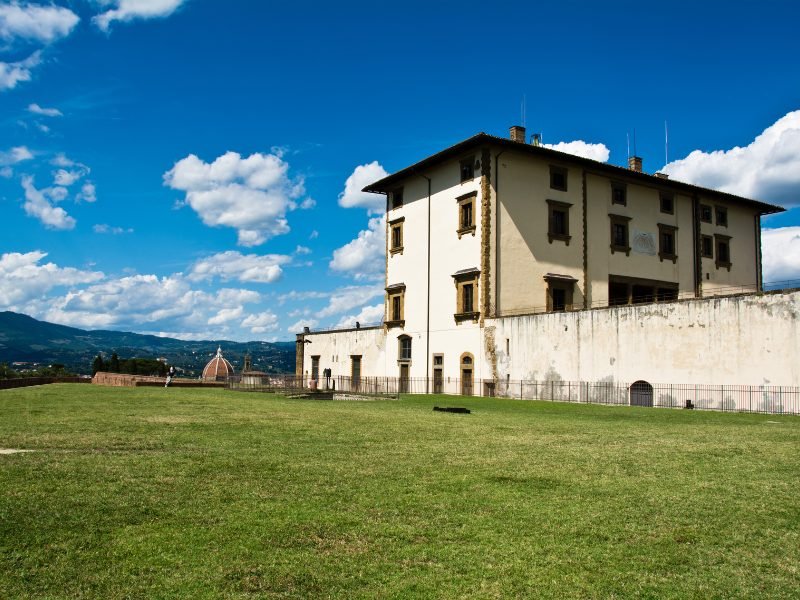
The 16th-century fortress near Boboli Gardens is another great spot to enjoy sweeping views of Florence’s skyline.
Like many important buildings in Florence, the fortress was built by the Medici family to protect the government seat at Palazzo Pitti — while also demonstrating their influence and power.
Aside from being an impressive historical landmark and offering stunning views of the city, the fortress regularly houses art exhibitions.
You can explore the outside area of Forte Belvedere for free, but you must pay a fee to see the inside and exhibitions.
Abbazia di San Miniato al Monte
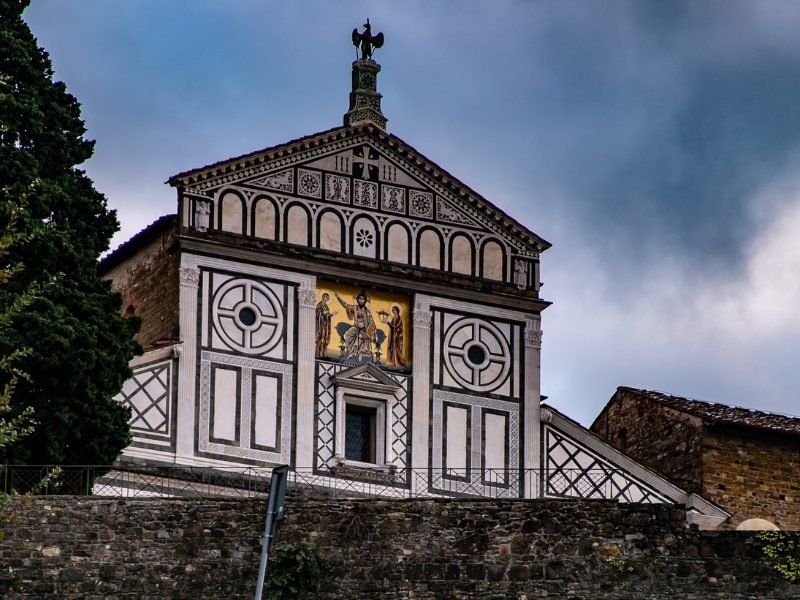
Not far from Piazzale Michelangelo, Abbazia di San Miniato al Monte is a beautiful 11th-century abbey on a hilltop offering astounding views of Florence!
The Romanesque façade of the abbey, which is covered in marble, is one of the most prominent features of this stunning landmark in Florence.
The abbey is among the finest examples of Romanesque architecture in Tuscany, so you really shouldn’t miss it!
Inside the church, you can admire a 13th-century mosaic of the Christ between the Virgin and St. Minias and the Cardinal of Portugal Chapel dedicated to a Portuguese ambassador who died in Florence.
If you need more reasons to visit the gorgeous abbey, entry is free, and there is no need for reservations!
If you want to keep exploring, check out some of these day trips from Florence, which include a lot of important Tuscany landmarks!

Roxana is a Romanian-born freelance travel writer who has lived in Italy for over 15 years. She has a Master’s in Journalism and a Bachelor’s in Film Studies, and she studied at Università degli Studi di Roma Tre. Besides her native Romania, Roxana has lived in Rome, Lisbon, and Berlin, and she has traveled through much of Europe in search of hidden gems, history, and culture.